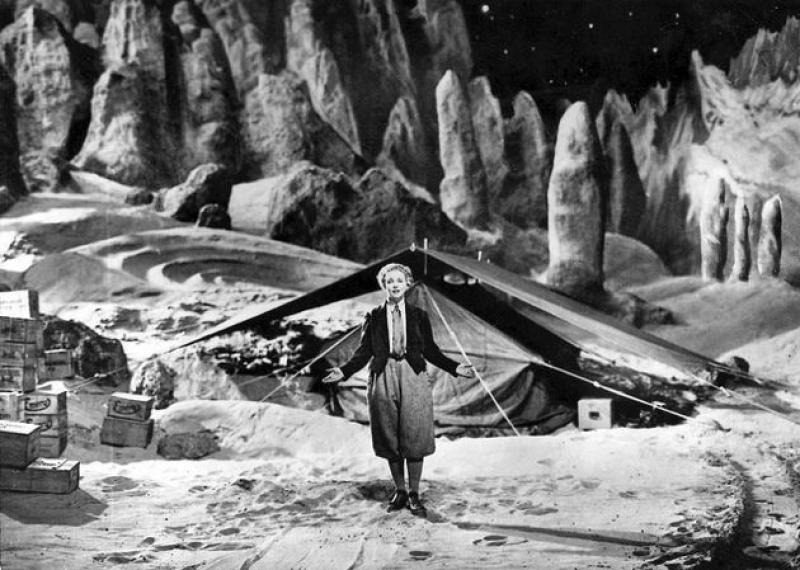DVD: Frau im Mond | reviews, news & interviews
DVD: Frau im Mond
DVD: Frau im Mond
Fritz Lang's lunar epic shines in a gleaming new print

So much of Fritz Lang's 1929 silent film Frau im Mond rings true that you're inclined to forgive its shortcomings – notably a protracted, slow first act which takes far too long to set the plot in motion. Which involves brooding engineer Helius (an intense Willy Fritsch) whose space programme is hijacked by a sinister, cigar-smoking cabal intent on plundering gold reserves located on the moon's dark side.
And then we lurch abruptly into sci-fi thriller territory. The extended technical explanation of how Helius's rocket will reach the moon is visually engaging, and the actual launch is spectacular. The flight is brilliantly realised, unsurprising considering that Lang's most notable scientific advisor was the famous rocket scientist Hermann Oberth (one of whose proteges was the young Wernher von Braun). The reverse countdown during takeoff was copied 40 years later by NASA, and the film's neat visual attempts to portray g-force and weightlessness stand up well in a post-Gravity world.
What ensues on the lunar surface won't surprise anyone who's familiar with Hergé's Tintin, but the closing moments are unexpectedly moving – Gustl Gstettenbaur as the heroic young stowaway almost steals the film. We sense that Helius and Friede (the radiant Gerda Maurus) will make a success of their new home, despite their comically inappropriate clothing. Eureka's extended, restored cut looks superb, and the piano soundtrack is effective but unobtrusive. The one bonus feature is a short, subtitled documentary on the making of Frau im Mond. It reveals that the Nazis banned the film in 1937, fearing that its realism was a little too close to their own clandestine rocket programme.
rating
Explore topics
Share this article
The future of Arts Journalism
You can stop theartsdesk.com closing!
We urgently need financing to survive. Our fundraising drive has thus far raised £49,000 but we need to reach £100,000 or we will be forced to close. Please contribute here: https://gofund.me/c3f6033d
And if you can forward this information to anyone who might assist, we’d be grateful.

Subscribe to theartsdesk.com
Thank you for continuing to read our work on theartsdesk.com. For unlimited access to every article in its entirety, including our archive of more than 15,000 pieces, we're asking for £5 per month or £40 per year. We feel it's a very good deal, and hope you do too.
To take a subscription now simply click here.
And if you're looking for that extra gift for a friend or family member, why not treat them to a theartsdesk.com gift subscription?
more Film
 Honey Don’t! review - film noir in the bright sun
A Coen brother with a blood-simple gumshoe caper
Honey Don’t! review - film noir in the bright sun
A Coen brother with a blood-simple gumshoe caper
 The Courageous review - Ophélia Kolb excels as a single mother on the edge
Jasmin Gordon's directorial debut features strong performances but leaves too much unexplained
The Courageous review - Ophélia Kolb excels as a single mother on the edge
Jasmin Gordon's directorial debut features strong performances but leaves too much unexplained
 Blu-ray: The Graduate
Post #MeToo, can Mike Nichols' second feature still lay claim to Classic Film status?
Blu-ray: The Graduate
Post #MeToo, can Mike Nichols' second feature still lay claim to Classic Film status?
 Little Trouble Girls review - masterful debut breathes new life into a girl's sexual awakening
Urska Dukic's study of a confused Catholic teenager is exquisitely realised
Little Trouble Girls review - masterful debut breathes new life into a girl's sexual awakening
Urska Dukic's study of a confused Catholic teenager is exquisitely realised
 Young Mothers review - the Dardennes explore teenage motherhood in compelling drama
Life after birth: five young mothers in Liège struggle to provide for their babies
Young Mothers review - the Dardennes explore teenage motherhood in compelling drama
Life after birth: five young mothers in Liège struggle to provide for their babies
 Blu-ray: Finis Terrae
Bleak but compelling semi-documentary, filmed on location in Brittany
Blu-ray: Finis Terrae
Bleak but compelling semi-documentary, filmed on location in Brittany
 Oslo Stories Trilogy: Sex review - sexual identity slips, hurts and heals
A quietly visionary series concludes with two chimney sweeps' awkward sexual liberation
Oslo Stories Trilogy: Sex review - sexual identity slips, hurts and heals
A quietly visionary series concludes with two chimney sweeps' awkward sexual liberation
 Sorry, Baby review - the healing power of friendship in the aftermath of sexual assault
Eva Victor writes, directs and stars in their endearing debut feature
Sorry, Baby review - the healing power of friendship in the aftermath of sexual assault
Eva Victor writes, directs and stars in their endearing debut feature
 Blu-ray: Who Wants to Kill Jessie?
Fast-paced and visually inventive Czech comedy
Blu-ray: Who Wants to Kill Jessie?
Fast-paced and visually inventive Czech comedy
 Oslo Stories Trilogy: Love review - freed love
Gay cruising offers straight female lessons in a heady ode to urban connection
Oslo Stories Trilogy: Love review - freed love
Gay cruising offers straight female lessons in a heady ode to urban connection
 Beating Hearts review - kiss kiss, slam slam
Romance and clobberings in a so-so French melodrama
Beating Hearts review - kiss kiss, slam slam
Romance and clobberings in a so-so French melodrama

Add comment